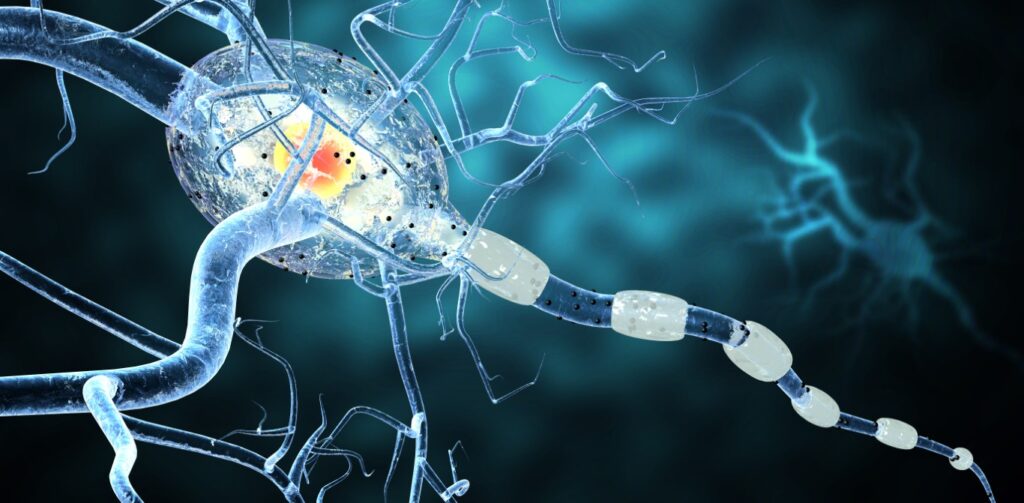Multiple sclerosis (MS) is a chronic inflammatory neurological disease that affects the central nervous system. Foot drop caused by MS can be improved by FES.
Multiple sclerosis is a chronic inflammatory disease in which the body attacks and permanently damages the protective sheath of nerve fibers. In Germany, an estimated 200,000 to 300,000 people are affected by this autoimmune disease. 70 percent of those affected are women. The breakdown of the so-called myelin disrupts impulse transmission and impairs nerve function. The command to move cannot be transmitted to the target muscle – according to a study by the MS Registry, around half of those affected cite limited walking ability as a symptom.
Multiple sclerosis causes the body’s own immune cells (known as phagocytes) to destroy the protective membrane of the nerve fibers called the myelin sheath. In the long term, this can no longer regenerate – scarred areas, known as plaques, develop. This process of hardening or sclerosis considerably restricts the ability to transmit impulses at the affected areas.
In the early stages of MS, motor disorders such as paralysis and visual problems caused by inflammation of the optic nerves (optic neuritis) often occur. In addition, there are often sensory disorders of the skin in the form of tingling, painful sensations or numbness. Various other symptoms can also occur, including unsteadiness when walking or grasping, double vision, bladder problems, incontinence and impaired articulation.

Another disorder can be peroneal nerve palsy or weak foot dorsiflexion, where the patient can no longer lift the foot when walking. Functional electrical stimulation can compensate for the loss of stimulation and help the patient to regain a safe, stable gait.
The symptoms of MS depend heavily on which areas of the nerves are hardened – i.e. where signal transmission is impaired. The symptoms can be roughly divided into two categories. The early symptoms include
In the later course of the disease, MS can lead to incontinence or loss of the sense of taste, among other things. In more severe cases, irreversible paralysis and movement disorders occur.
Devices based on“functional electrical stimulation” (FES), such as TENS devices, can be effective. These combine state-of-the-art technology with therapeutic expertise. If signal transmission between the brain and foot is impaired, electrical impulses directly on the leg take over this function. The FES devices are placed around the lower leg below the knee. Sensitive sensors detect the intended movement. Electrical impulses are then triggered at the electrodes, which are placed on the skin, at the right moment. The target is the so-called peroneal nerve, which is responsible for the controlled lifting of the foot and is stimulated by the electrical stimulation.
The main impairments in multiple sclerosis result from impaired signal transmission from the brain via the nerve pathway to the muscles.
EMG-controlled multi-channel electrostimulation even opens up the possibility of relearning complete movement sequences, for example when gripping or walking.
Biofeedback training can help to improve coordination in multiple sclerosis. Visual feedback supports relearning in the case of sensory disorders, particularly sensory disorders. Biofeedback can also be used for pelvic floor training in the context of bladder or rectal disorders.
However, electrotherapy is not only useful in the early phase. Electrotherapy can also be used in later rehabilitation phases, when the focus is on spasticity, in order to influence this increased muscle tension. Repeated applications in a functional context enable successful therapy according to the principles of motor learning.
The wireless foot drop system innoSTEP-WL is an easy-to-use device...
The innoSTEP-WL is an innovative, wireless FES system for functional electrical stimulation in cases of weak foot dorsiflexion and can help patients to improve their mobility and quality of life: Impulses are sent to the peroneal nerve (fibular nerve) via electrodes on the leg and transmitted to the shin muscle (tibialis anterior muscle) so that the foot lifts when walking. The foot lift system thus enables a more natural, safer gait pattern through electrical stimulation. In the long term, the repeated transmission of stimuli through the central nervous system together with effective EMS training can lead to neuronal realignment and a lasting improvement in gait.
Neurologists and specialists play a key role in the comprehensive care of foot drop and multiple sclerosis. A collaborative approach between different specialists ensures holistic care and individualized treatment plans.
HELLER MEDIZINTECHNIK GmbH & Co. KG has been a certified medical technology company for over 25 years and has many years of experience in designing solutions in the field of electrical nerve and muscle stimulation.
2025 © HELLER MEDIZINTECHNIK GmbH & Co. KG